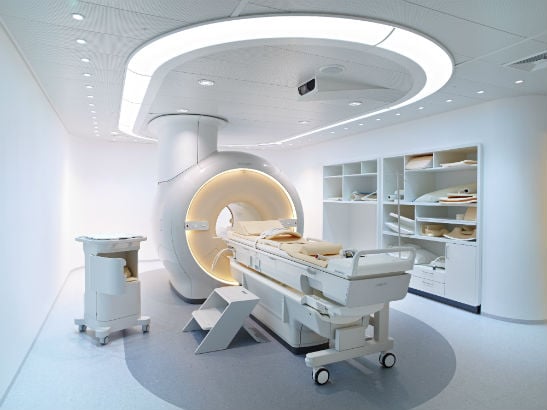When you hear the word ultrasound what springs to mind? Perhaps pregnancy scans or bats flying in the night sky?
Ultrasound is the name used to describe sound waves that have frequencies too high to be detected by the human ear. They are used in nature by bats and porpoises for navigation, and by humans in a whole host of industrial and medical applications, from measuring distances, to accelerating chemical processes, to health diagnostics.
The beauty of ultrasound is its ability to go unnoticed and not leave a trace – except to those capable of detecting the high-frequency waves.
So it might come as a surprise to know that researchers and clinicians at The Institute of Cancer Research and The Royal Marsden are using ultrasound, focused to be 10,000 times more powerful than that used in pregnancy scans, to destroy nerve tissue to treat cancer pain.
The technique, known as high-intensity focused ultrasound (HIFU), concentrates high-power sound waves to create heat in the same way that a magnifying glass can concentrate sunlight to burn paper. Ultrasound waves can be focused so intensely that they can destroy tissue when precisely targeted within the body.
We recently invited a small group of journalists to come and see the HIFU facility and to meet experts working in the area, resulting in media coverage which included a piece in the Observer. Researchers and clinicians at the ICR and Royal Marsden have been central to a growing movement to explore the potential of ultrasound as a treatment. In 2013 the ICR and the Royal Marsden became a Focused Ultrasound Foundation centre of excellence, and last year we embarked on a clinical trial to use focussed ultrasound to burn away nerve endings in patients with advanced cancer with bone metastases.
The trial is part of a wider initiative between the ICR, The Royal Marsden, the Focused Ultrasound Foundation and Philips, the developer of the HIFU system. This collaboration is creating a state-of-the-art resource for clinicians and scientists to establish global standards for focused ultrasound and accelerate development of the technology to treat cancers.
Professor Gail ter Haar, Professor of Therapeutic Ultrasound at the ICR, has been instrumental in pioneering ultrasound as a potential cancer treatment. She told me: “We see instant cell death if we achieve a temperature of 50°C in tissue, and hold it for one second using HIFU, and we can deliver this very accurately, to within a six cell margin.
“We use state of the art MRI scanning to guide delivery of focused ultrasound during the treatment. Not only does it allow us to monitor how hot the tissue is getting, it also provides very good contrast so we can precisely target the correct area.”
Professor Nandita deSouza, Professor of Translational Imaging at the ICR and Consultant Radiologist at The Royal Marsden, gave us an update on the trial: “We have now used HIFU to treat a number of patients with advanced cancer. The patients we are treating are in a lot of pain – tumours that have spread to their bones are pushing against nerve endings. Other treatments have failed, and there are no options left to them. HIFU has given us a way to reduce the pain these patients are experiencing. Remarkably, as tissue dies instantly, some of our patients have seen an immediate effect in terms of pain reduction.”
Though HIFU as a cancer treatment is at an early stage of development, it is hoped in the long term that the technique could be used to destroy tumours. The areas surrounding the treatment site are unlikely to be affected; ultrasound does not harm cells when it is not generating heat. This means it may hold promise for patients who are unable to have surgery or who have already reached a maximum dose of radiotherapy.
“We are really excited about the potential of this technique. We can see how it could benefit patients, but we are still some way from offering this to patients as a cancer treatment,” said Prof deSouza. “However, if the results from our trial continue to be positive, we would hope to run further trials directly targeting tumours with HIFU for patients who have no other treatment options.
“This treatment is very patient-friendly; it involves no invasive procedures as it can be delivered from outside of the body.
“In the long term, we hope that we could develop HIFU as a treatment for cancer for doctors to have in their toolkit alongside established treatments such as radiotherapy, surgery, chemotherapy and targeted treatments.”
So the day that we see ultrasound used as a treatment as well as a diagnostic may be approaching. Watch this space for regular updates.

The quiet revolution: how high-frequency sound waves are being used to treat cancer pain
05/11/15 - by Claire Bithell